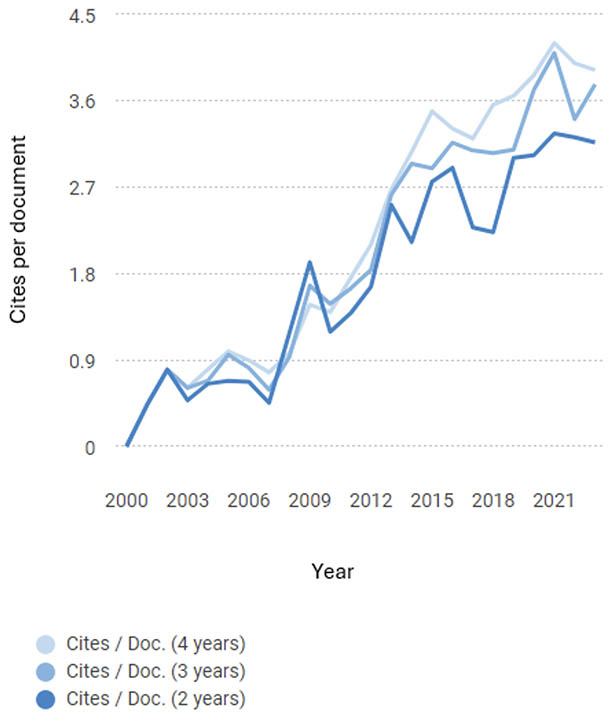
Volume 26, Number 1
Terry Anderson1, Peter S. Cookson2, Serena Henderson1, and Rory McGreal1
1Athabasca University, 2Delaware State University
Since its founding in 2000 by Athabasca University, the International Review of Research in Open and Distributed Learning (IRRODL) has emerged as a leading platform for the dissemination of scholarly work in open and distributed learning. This article revisits IRRODL’s foundational goals, the institutional support that facilitated its creation, and its evolution over 25 years. Through this retrospective, we celebrate the journal’s achievements and examine its future as a freely accessible repository of information and knowledge for practitioners and researchers in open and distributed learning.
Keywords: online journal, open access, open source, publication
IRRODL is a leading voice in the field of open and distributed learning, helping shape the discourse on open education and online learning theory and practice. With its commitment to open access, IRRODL provides a platform for researchers worldwide to share research results thereby fostering a global community of scholars and practitioners. Its comprehensive coverage of topics—ranging from open practices and pedagogical innovations to emerging technologies—ensures its relevance to academics and educators seeking evidence-based insights, best practices, and strategies. By bridging theoretical advancements with practical insights, IRRODL has become a force and resource—helping shape the future of open and distributed learning.
Open access (OA) ensures that scholarly research is freely accessible to all, breaking down barriers to information due to subscription costs or institutional access limitations. This democratization of knowledge fosters equity, enabling researchers, educators, policymakers, and the public worldwide to engage with research findings without financial hindrance. Open access distribution facilitates collaboration, innovation, and the adaptation of research for and from diverse contexts—empowering institutions and individuals to improve practices and outcomes. By removing paywalls, OA promotes transparency and accelerates the global exchange of ideas, vital for addressing challenges including sustainability, health crises, and education and research disparities.
The rise of online education has transformed teaching and learning paradigms. These changes are fueled by advancements in technology and the demand for flexible, inclusive access to education—even in times of war and epidemic. Online educational practices emphasize interactivity, learner autonomy and self-direction, and accessibility, while theoretical frameworks have expanded to address issues such as openness, digital equity, attrition, engagement in virtual environments, and the design of learning-centered curricula. This evolution has created opportunities and challenges as researchers explore digital tools and platforms to measure if they enhance learning effectiveness and address diverse learning needs.
Bridging the gap between theory and practice is essential for advancing education. While theoretical frameworks provide foundational understanding, their real-world application ensures relevance and impact. Educators and institutions are challenged to translate scholarly insights into actionable strategies that address challenges in open and distributed education. This dynamic exchange between research and practice fosters innovation, improves teaching effectiveness, and enhances learning outcomes. Extending scholarship to practice also enriches research, as practical applications often reveal new areas of inquiry, leading to a continuous cycle of knowledge generation and refinement.
In 1970, Athabasca University (AU) was initially conceived as a traditional, campus-based institution. However, a pivotal shift occurred just two years later, transforming AU into an open university focused on distance education. Through innovative correspondence courses and the early adoption of digital technologies, AU led the way in online learning in Canada. By the late 1990s, AU had already leveraged advancements using the Internet and online learning platforms, while adopting both synchronous and asynchronous digital learning modes enabling students to overcome geographic and temporal limitations.
The establishment of the International Review of Research in Open and Distance Learning (IRRODL) in 2000 was a natural extension of AU’s commitment to broadening access to education. With AU’s institutional support, the journal was born digital and so was able to harness online platforms to publish research that reaches a worldwide audience of scholars and practitioners in distance education. The flexibility and accessibility that digital dissemination provided made IRRODL a crucial resource for overcoming barriers to educational research sharing, echoing AU’s motto as “Canada’s Open University.”
The journal’s name, International Review of Research in Open and Distance Learning, reflects its commitment to inclusivity, diversity, and rigorous scholarship in the field:
The title thus encapsulates IRRODL’s mission of advancing global knowledge on distributed education and expanding access to research for all readers.
In 2016, with support from UNESCO and with a growing understanding of changes in the field of distance education, IRRODL widened its focus to include articles on open educational resources (OER) and open practices (OP) as well as the growing number of hybrid and blended courses becoming available from traditional institutions. In recognition of this expansion, the journal name was changed to refer to distributed learning, replacing the term distance in the title, and became the International Review of Research in Open and Distributed Learning.
The initial success of IRRODL was significantly bolstered by institutional backing from AU. Key contributors included the former Associate Vice-President for Research and Institutional Studies, Dr. Peter Cookson, who served as the founding editor, and a part-time Managing Editor responsible for implementing essential submission and publication processes. Additionally, AU’s International Consortium for the Advancement of Academic Publication provided technical support, solidifying IRRODL’s operational foundation.
To reinforce AU’s commitment to establish a journal whose content was truly international, we invited an internationally diverse group of leading distance education theorists, researchers, and practitioners to serve on IRRODL’s Editorial Board or as Consulting Editors. To that end, we sought high profile distance educators (people who constituted a virtual who’s who of contributors to the growth of distance education in their countries and/or internationally). Seventeen outstanding distance educators from 12 countries agreed to serve on the Editorial Board. Twenty-nine distance educators from 19 countries agreed to serve as Consulting Editors. Beginning with the inaugural issue, members of both groups were instrumental in enabling IRRODL’s goal of geographical diversity of contributors and contributions.
Diamond OA journals are those that do not require payment of article processing charges (APCs) or other fees from either authors or readers. Although the term diamond OA has been coined only recently, IRRODL has been diamond from its inception, and it has been awarded the Directory of Open Access Journals (DOAJ) Seal for best practices in open access publishing.
IRRODL was the first journal in Canada to be released as open access, charging no fees for subscriptions or for general readers and no publication charges to authors. IRRODL’s open access model aligns with AU’s mission as an open university. The journal’s financial sustainability at first depended solely on support from AU. Later, the journal received ongoing triennial grants from the Canadian Social Sciences and Humanities Research Council (SSHRC). In 2016, IRRODL also received one-time funding from UNESCO to increase its mandate to include OER and OP as well as distributed forms of education. These funds have been crucial for supporting innovations and for covering operational expenses, including technical infrastructure and managing the submission and publication processes.
The first issue of IRRODL set the stage for a new approach to scholarly publishing. It featured a two-part structure: a Main Section dedicated to in-depth articles on theory, research, and practice, and a Notes section with news on developments in open and distance learning. Under the theme “The Problems and the Promise: Into the New Century,” the issue included contributions from internationally respected scholars, quickly establishing IRRODL as a platform for the global discourse in the evolving field of distance education. Over the years IRRODL has experimented with a variety of specially focussed sections, including technology reviews, leadership articles, book reviews and special issues.
When IRRODL was founded, the Canadian research funding agency, SSHRC, did not support open access journals. Even though IRRODL had more than two thousand subscribers, it was not eligible for funding because SSHRC insisted that they must be paying subscribers, which of course was anathema to an open access journal. As a result of this policy, IRRODL put out a plea for a voluntary payment of $10 Canadian to all subscribers and within a week received more than 100 positive responses. This information was conveyed to SSHRC, but they still did not allow IRRODL to qualify for funding. However, for the next call, SSHRC altered its rules to allow open access journals to participate, and IRRODL began receiving funding that continues to the present. IRRODL, as the first open access journal in Canada, was also the first to receive SSHRC funding. Ironically, in 2015 SSHRC reversed its policy and now only funds open access journals!
With the departure of founding editor Peter Cookson, Terry Anderson took over as editor in IRRODL’s third year. His tenure coincided with a period of rapid technological advancement, enabling IRRODL to introduce multiple article formats, including MP3 audio, as well as PDF, HTML, and EPUB. A translation widget was added, enabling articles to be read in multiple languages.
As open access journals gained traction and popularity a host of predatory journals emerged to exploit article processing charges thus creating a shady business model. For IRRODL, this meant that maintaining credibility was paramount. To preserve high standards, IRRODL rigorously enforced peer review, with all articles subject to double-blind evaluation by two or more reviewers. Double-blind peer review is widely recognized as an effective method to ensure objective feedback and rigorous evaluation. In this system, neither the authors nor the reviewers know each other’s identities, theoretically eliminating bias. However, this approach also comes with challenges: the anonymity it affords can reduce accountability; and, the volunteer nature of reviewing can lead to inconsistent quality and timeliness in the review process. Finding quality reviewers remains a challenge, especially given the constraints on volunteer labour in academia. To address this, IRRODL became one of the first to implement the Public Knowledge Project’s (PKP) Open Journal System (OJS). This system supports journal management, administration, and distribution and importantly, allows editors to assess reviewer quality and track their expertise.
Continuous innovation and adaptation is important as IRRODL seeks to maintain its leadership position in scholarly publishing. IRRODL’s approach has evolved over time to remain responsive to the changing needs of the academic community. Special issues allow IRRODL to focus on contemporary topics, offering readers in-depth insights into pressing issues while fostering editorial growth and expertise. Special issues also provide unique advantages to both the editorial team and the broader scholarly community. They offer cohesive focal points on specific themes and draw attention to areas of emerging importance within ODL. Expert contributions from scholars who may not otherwise submit to the journal help broaden IRRODL’s reach and influence. Some special issues on enduring topics like student support, cost issues, and the future of open universities remain highly relevant years after publication.
CIDER sponsors a variety of professional development activities designed to increase the quantity, quality, and distribution of distance education research. CIDER, founded by the IRRODL editor, was designed to promote professional development in online learning and teaching by delivering monthly webinars. The CIDER sessions are online, open, and free, providing a forum in which researchers or research groups can present their work to a broad audience of fellow researchers, practitioners, and students from across Canada and internationally.
Another initiative of IRRODL, originally sponsored by UNESCO, is the OER Knowledge Cloud. It is a repository of more than 2,800 scholarly articles and reports related to open educational resources, including MOOCs and open practices. It houses searchable records of journal articles, reports (e.g., from government or industry), books and other items in any digital format. These articles and reports are available either directly from the cloud repository or by links to their sources.
Two notable innovations that were trialed include public commenting and continuous publication, both of which yielded important lessons. Public commenting was enabled through the OJS application. This allowed readers to leave public comments on published articles, with the aim of promoting open dialogue and community engagement. However, this innovation did not prove to be popular with the community and very few comments were recorded. Academic readers, often constrained by their own publishing demands and time, simply did not engage in public critique or discussion of others’ work—at least not directly and publicly in our journal. This experiment underscored that while public commenting is a popular obsession, it requires scholarly commitment, quality control, as well as a significant cultural shift in academia.
Another innovation was IRRODL’s move toward continuous publication. Traditionally, journals follow an issue-based model where all articles are published simultaneously on a regular, if not scheduled basis. IRRODL’s experiment with continuous publication aimed to reduce the time between submission and publication by releasing articles individually as they completed the review and editing processes. Although this approach had the advantage of faster publication, it presented challenges in terms of article visibility, promotional efforts, peer acceptance, and editorial workload. In response to these challenges, IRRODL returned to the scheduled publication of issues. However, it continues to refine its publication processes, demonstrating a commitment to evolving in line with best practices and the needs of its contributors.
The journal’s credibility and impact grew significantly when IRRODL achieved inclusion in prestigious citation indexes such as the Thomson Reuters Social Science Citation Index (SSCI) in 2009. This milestone marked IRRODL’s acceptance into the global academic mainstream, making it a more attractive venue for submissions from researchers worldwide. With subsequent indexing by Scopus and the Directory of Open Access Journals (DOAJ), IRRODL established itself as a leading source of information in the field of distance education.
IRRODL Expansion
Citation indexes such as Scopus and Google Scholar place IRRODL as the most cited Canadian education journal and in the top 20 educational technology journals published globally. A measure of academic importance of both individual articles and research journals is the number of times an article or a journal is cited by other authors, indicating the relative influence of the work on the scholarly community. Data from this metric are shown in Figure 1. IRRODL has been rated among the highest impact distributed learning journals and in the top ten of educational technology journals.
Figure 1
Citations Per IRRODL Article Over Time

Note. Citation numbers were determined by dividing the total number of IRRODL citations by the number of published articles. The lines show the growth in the average number of times that articles from the past 2, 3, and 4 years were cited in the current year. The two-year line, shown in dark blue, represents IRRODL’s impact factor.
Adapted from “International Review of Research in Open and Distance Learning,” by Scimago Journal & Country Rank, 2024 (https://www.scimagojr.com/journalsearch.php?q=17781&tip=sid&clean=0).
However, citations alone cannot reflect all the value. Practitioners, as opposed to researchers, may find an article very useful or insightful, and yet, as they are not active authors, the value of the work for them is not reflected in number of citations. We know from discussions and from our own presentations at practitioner conferences that IRRODL is widely read. Its openness is critical for those without access to research libraries and databases.
An easy metric of a journal’s relevance is to count the number of page views and downloads, or the number of subscribers—those who are notified when a new issue is released, keeping in mind that robot crawlers can inflate these numbers. To further complicate download counts, as an open access journal, copies of IRRODL articles are routinely posted online by governments, institutions, and authors. Regardless, Figure 2 shows that views and downloads are measured in the millions.
As shown in Figure 2, IRRODL has attracted over four million visitors and recorded more than 13 million downloads since 2011, indicating a significant engagement rate with its content. This suggests that visitors find the journal’s offerings highly valuable, with each visitor downloading an average of over three articles. This level of interaction implies a strong reputation and relevance of a journal within its field, evidencing that it is a critical platform for disseminating research. IRRODL’s high download figures could also reflect the accessibility of content, possibly through open access or appealing topics. These metrics underscore the journal’s influence on the broader field of educational technology.
Figure 2
Visitors to and Downloads From IRRODL Since 2011
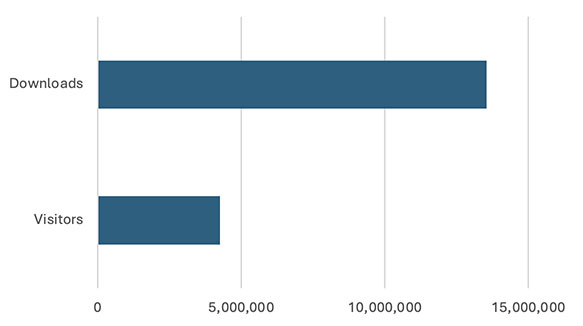
Note. Downloads include all formats available on the site: PDF, EPUB, HTML, and MP3; exact number of downloads is 13,539,958 and visitors are 4,254,355.
The number of IRRODL article visits (707,778) and downloads (21,945) since 2023, according to the Érudit website, is also impressive. See Figure 3.
Figure 3
Downloads and Visitors Since 2023 According to the Érudit Website
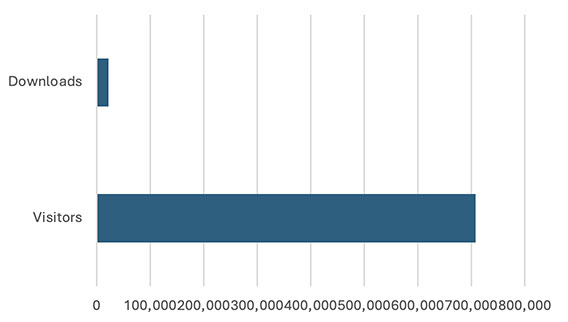
Note. Downloads include only PDF documents.
Figure 4 shows that authors come from many countries—and Figure 5 reveals that the majority of readers are from the Global South—thus demonstrating the international nature of the journal. Between 2023 and 2024, IRRODL published research articles from 31 different countries, highlighting its commitment to educational innovation and access.
Figure 4
Number of Articles Published by Country (2023-2024)
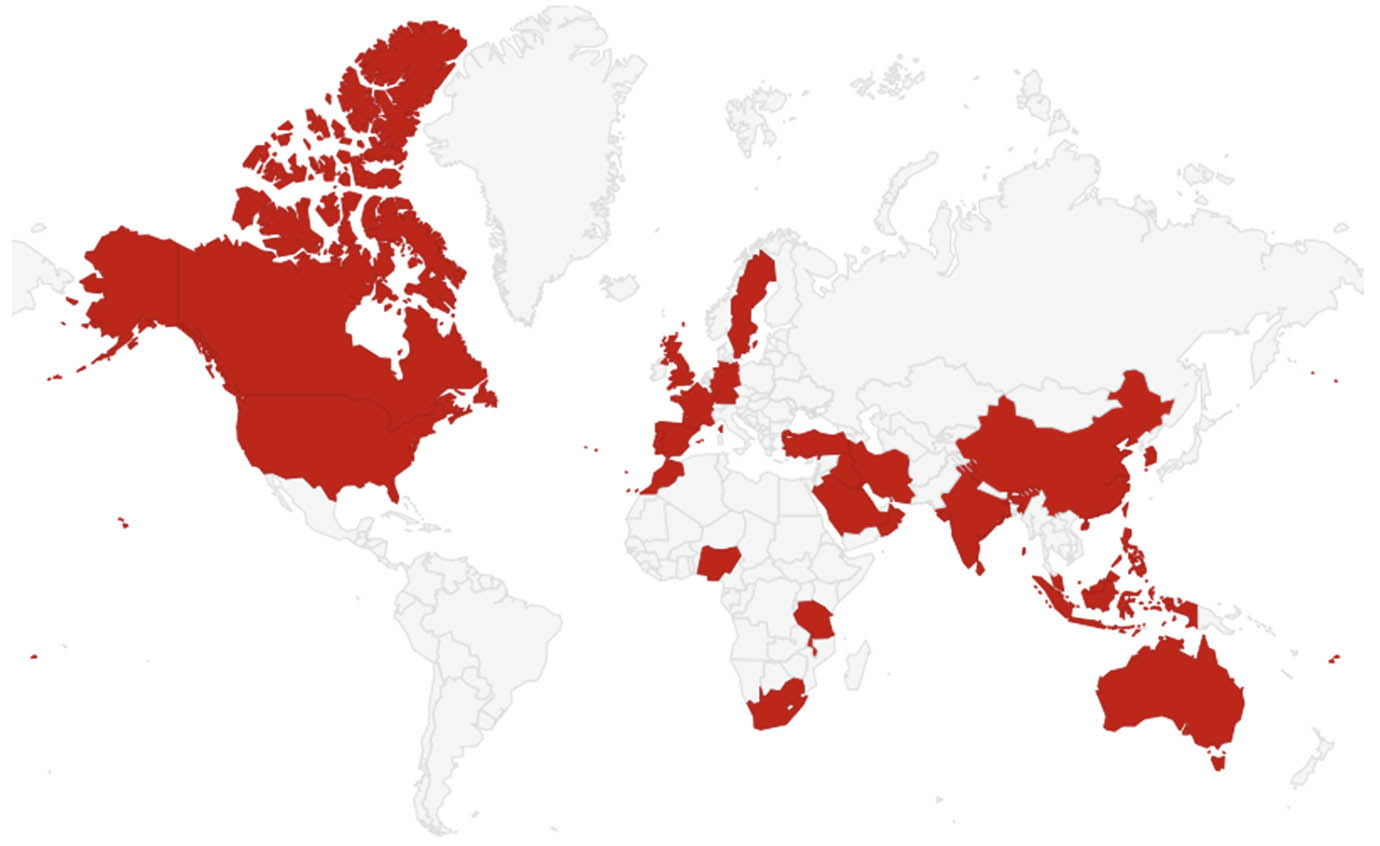
IRRODL demonstrates a strong global user base with 64.3% of its audience from the Global South, 14.7% from the Global North, and 21.0% from other or unidentified regions (see Figure 5). This distribution highlights the journal’s broad international reach and the significant engagement from the Global South. Rather than reflecting lesser interest in open and distributed learning in the North, the disparity is likely influenced by stronger digital infrastructure and research investments in these regions. Conversely, the strong participation from the Global South underscores both a growing demand for open-access resources and potential barriers such as limited Internet access, resource constraints, or awareness gaps.
Figure 5
IRRODL Website Visitors/Readership
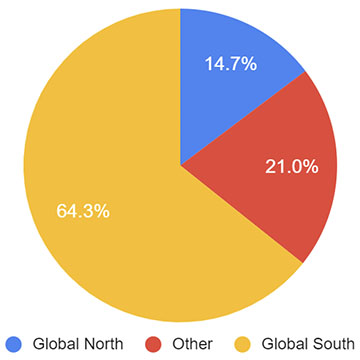
The journal also draws reviewers from around the globe by requesting IRRODL authors to participate as reviewers. This helps the journal achieve balanced and globally relevant reviewer perspectives. In addition to maintaining geographical diversity, IRRODL has invested in accessibility options for its readers, expanding beyond traditional publication formats. This commitment to accessibility has been a guiding principle, ensuring that IRRODL’s content is available and adaptable to various audience needs.
In addition to its substantial citation and download metrics, IRRODL enjoys a diverse and geographically widespread readership. Between 2011 and 2024, Google Analytics recorded a total of 4,254,355 visitors to irrodl.org (Figure 6). The countries with the highest number of views were:
This further reinforces IRRODL's broad international impact, particularly in regions such as the Philippines, India, and Nigeria, where open and distance learning plays a crucial role in overcoming educational barriers.
Figure 6
Total Number of Visitors to irrodl.org Between 2011-2024
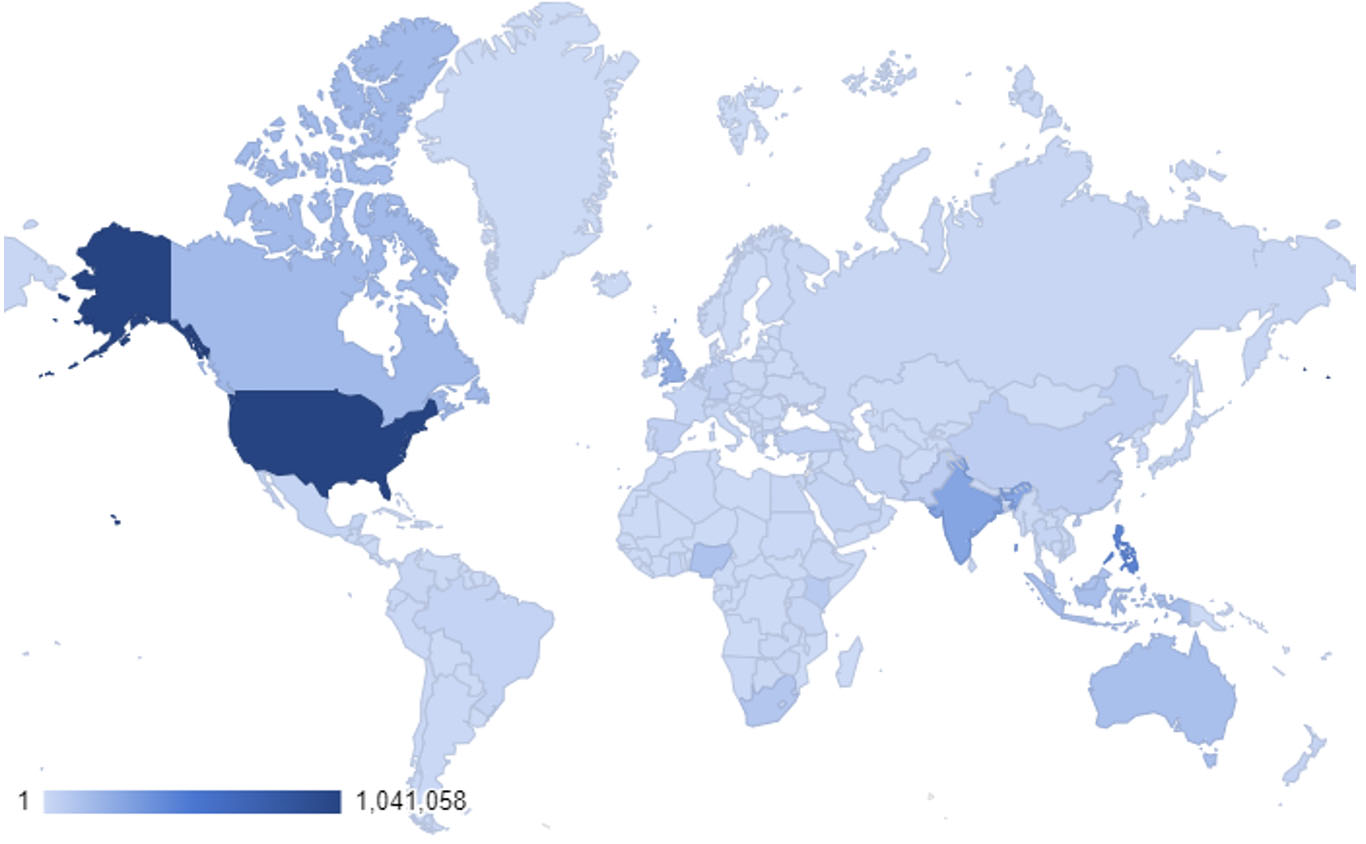
At its peak, IRRODL published up to six issues annually, with as many as 115 articles each year, requiring the editorial team to oversee a demanding review, assessment, and editorial process. Technically, this involved and still involves producing each article in multiple formats—HTML, PDF, and EPUB. From 2006 through 2019, IRRODL also included an MP3 audio version of each article, which was very helpful for visually impaired users. However, by 2019, text-to-speech applications had become ubiquitous. Because producing MP3 files is very time-consuming, the decision to stop their production was made beginning in 2020.
The IRRODL team’s focus on quality reviews, accessibility, and professional formatting was important for ensuring the journal’s reach and accessibility to a global audience.
By 2020, the rising demands led IRRODL’s editorial team to reassess their position. Coping with the success of the journal had become problematic. The continued processing of so many submissions was unsustainable. At the same time, IRRODL was moved organizationally within the university to AUPress, the first open access publisher in Canada. A committee formed by AUPress advised the editorial team to limit issues to four per year and the total number of published research articles was limited to 40 per year. The Managing Editor position was increased to full time and more copyeditors, research assistants, graduate students, and technical staff were engaged to streamline operations. This enabled the Managing Editor to concentrate on enhancing editorial quality rather than solely managing volume. In addition, a statistician was put on contract to assist in reviewing articles that contained complex quantitative research. These measures were designed to create a sustainable framework for maintaining and improving high publication standards. Later, IRRODL also agreed to be hosted on the Érudit website. Érudit is the largest host of Canadian open access research publications, primarily in the humanities and social sciences.
IRRODL has now become a leading journal for research in open and distributed learning. As an open access leader, from 2001 through 2024, IRRODL received 6,679 submissions, of which 1,304 were accepted, reflecting an overall acceptance rate of about 19.5%.
Figure 7 shows the number of submissions from 2006 to 2024.
Figure 7
Total Annual Submissions to IRRODL, 2006–2024
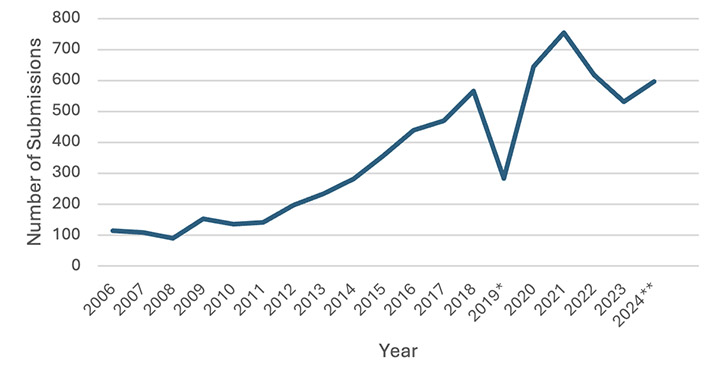
Note. *Only 4 months of this year were open for submissions. **Date includes up to October 27, 2024.
The surge in submissions has significantly increased the demands on the Managing Editor. This role now requires extensive expertise in the pre-review vetting of submissions for subject relevance, APA style, article length, and originality; post-review editing and digital publication process; and quality control to uphold international publication standards. Additionally, the Managing Editor coordinates complex publication logistics and oversees the entire submission to publication process, demonstrating leadership in the global landscape of open scholarly publications.
The peer review process is essential in maintaining a journal’s credibility. However, securing timely, high-quality reviews in a specialized field such as open and distributed learning poses a persistent challenge as peer reviewers often face significant time constraints. To address this, IRRODL’s editorial team normally requires at least two quality reviews per submission before making publication decisions. This practice, while necessary for upholding IRRODL’s standards, has sometimes resulted in delays in the publication process.
From the beginning, one of IRRODL’s most pressing challenges has been balancing the pace of publication with the need for rigorous peer review. To address this problem, IRRODL not only solicits experts in the field, but also asks authors, on publication of their article, to become peer reviewers. In recent years, IRRODL’s editorial team has also actively recruited peer reviewers at academic conferences and professional gatherings, building a network of skilled reviewers.
By tightening acceptance criteria for submissions, and instituting a cap on annual publications, the journal has created an environment where only the most rigorously reviewed articles proceed to publication. The Managing Editor rejects submissions that do not adhere to the guidelines or are not within the ODL scope of the journal. This limits the number of articles sent to editors. This strategy not only supports the journal’s reputation for quality, but also helps ensure a manageable workload for reviewers, thereby improving the peer review experience. Reviewers are normally sent no more than two articles per year. This is important for attracting and keeping good reviewers. Using the OJS application, all reviewers are rated on a scale ranging from excellent to unacceptable or no response. Although reviews are almost always undertaken by PhD level academics, we also realize the learning that occurs when one reviews an article and later sees the reviews of that same article by 2nd and 3rd reviewers. To leverage this learning, we have allowed doctoral level students to review some articles and found that they can provide acceptable reviews. It remains a continuing challenge to obtain good reviews in a timely manner. This challenge has caused significant delays for some authors awaiting decisions on their submissions.
The journey of IRRODL as a pioneer of innovative practices in open access and publication reflects a journal willing to evolve to meet the demands of an ever-changing academic landscape. Special issues have enabled IRRODL to focus on timely and relevant topics, offering comprehensive coverage that benefits researchers, practitioners, and policymakers alike. The creation of CIDER and the OER Knowledge Cloud as IRRODL-related initiatives, demonstrates the journal’s leadership in taking full advantage of the evolving digital environment. Even the experiments with public commenting and continuous publication underscore IRRODL’s role as a trailblazer in open access scholarly publishing, willing to challenge traditional models in pursuit of greater transparency, timeliness, and quality.
While challenges in reviewer selection, accountability, and volunteer management persist, IRRODL’s successes in these areas underscore its resilience and adaptability. As the field of ODL continues to grow, the lessons IRRODL has learned through its innovative practices will undoubtedly shape future advancements in academic publishing.
The evolution of IRRODL can be seen as a response to broader shifts in academic publishing, that highlights the growing complexity of running a leading scholarly journal. By restructuring, implementing workflow efficiencies, and fostering international and diverse scholarship, IRRODL has set a high standard for open access academic publishing. As the journal continues to adapt to new challenges and opportunities, Athabasca University and AUPress will continue to ensure that IRRODL’s contributions to scholarly discourse are timely, relevant, and accessible to a global audience. Through these efforts, IRRODL reaffirms its commitment to advancing knowledge in open and distributed learning and supporting the broader open-access movement.
In its first 25 years, IRRODL has been a successful diamond open access journal, internationally recognized platform for evaluating, distributing, and curating research in open and distributed education. By fostering a diverse and global community of readers, contributors, and reviewers, IRRODL has helped to shape the discourse on distributed learning and expand the availability of research for practitioners and scholars worldwide.
As IRRODL enters its second quarter-century, it remains committed to removing barriers to knowledge sharing and to advancing innovative research and best practices. Future efforts will focus on sustaining financial viability and expanding IRRODL’s reach, while maintaining the rigorous scholarly standards that have defined the journal since its inception. IRRODL continues to push the boundaries of open-access publishing by exploring the integration of artificial intelligence (AI) in academic publishing workflows, enhancing accessibility options for readers, and promoting the open-access model globally with a greater focus on the Global South. The editorial team plays a crucial role in these initiatives, providing strategic insights into how new technologies and editorial practices can sustain IRRODL’s legacy as a diamond open access journal in the educational technology field.
The continuing support of Athabasca University and SSHRC have been critical to the success of the journal. A special thanks is also extended to our contributors and reviewers. Finally, we acknowledge the editors, associate editors, managing editors, editorial board members, copy editors, and technical support that have contributed to the IRRODL’s continuing success.
This article benefited from the use of OpenAI’s ChatGPT-3.5 for drafting text and language refinement.

Twenty-Five Years of Innovation and Knowledge Sharing: The Legacy and Future of the International Review of Research in Open and Distributed Learning by Terry Anderson, Peter S. Cookson, Serena Henderson, and Rory McGreal is licensed under a Creative Commons Attribution 4.0 International License.